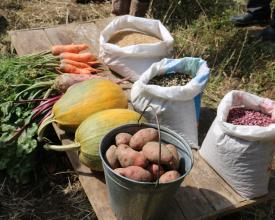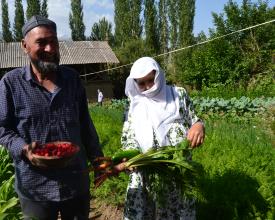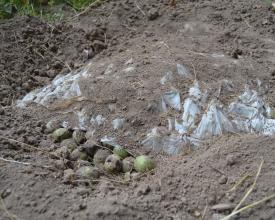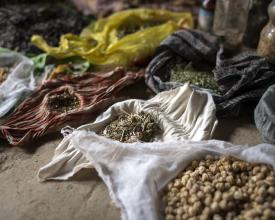
Diversified kitchen gardens

Kitchen gardens are very important for improving the nutrition of Tajik families in rural areas as they contribute to food and nutrition security by providing a diversity of vegetables, herbs, and berries.
Thus, they are a central nutrition source for subsistence farmers.
Vegetable, herbs, and spices, berries and fruits are cultivated in small-scale kitchen gardens, often directly adjacent to houses. The diversified kitchen garden approach aims to improve the management system of kitchen gardens by diversifying cultivated crops, enhancing irrigation systems and improving techniques for better soil fertility management.
Context
Challenges addressed
Promoting diversified kitchen gardens in the context of biodiversity and ecosystem services enhancement poses some challenges. Management of diversified kitchen gardens demand a sound knowledge of the requirements of different crops and makes having a cropping plan and rotation system essential, even though the size of a kitchen garden is normally relatively small. Intensifying production in a kitchen garden also requires pest and disease management and entails fertilization of crops, fruits, and vegetables through composting and green manure use.
Other challenges are represented by the lack of seed availability, the seeds of vegetables are not commonly reproduced, and the crops are not planted according to the seasonal calendar.
Location
Process
Summary of the process
The application of simple techniques such as composting and crop rotation improves the soil structure and reduces pests and diseases. Consequently, the quantity and quality of the harvest of vegetables and fruits are improved, from which seeds of better quality can be kept. These can be stored in community-based seed banks, thus ensuring that the traditional, local varieties of vegetables, fruits and herbs, which are usually better adapted to local climate conditions, are conserved.
Building Blocks
Preparing compost
By decomposing organic matter, natural soil fertilizer can be generated from what is usually regarded as waste. Organic matter as weeds, leaves, cut grass, residuals from harvest, animal dung, ash, green and brown pruning material, kitchen waste, such as eggshells and vegetable peels and other organic materials are mixed and decomposed by microorganisms for producing long-acting manure.
Compost not only improves the soil structure but also its porosity, creating a better environment for the root system of plants. It also increases the permeability of heavy soils and reduces erosion and runoff by increasing the soil's water retention capacity.
Compost supplies a variety of macro and micronutrients and in general a significant amount of organic matter to the soil.
Compost also can be used for preparing liquid manure, a very quick-acting organic top dressing which can be applied if vegetables show a deficiency of nutrients or are in a phase when they need many nutrients, e.g. tomatoes after flowering.
Given the climatic conditions in Tajikistan, with very dry summer and cold winter, compost is normally produced in pits. Most commonly, a two-pit system is recommended.
Enabling factors
Preparation of compost is easy and allows using and recycling own resources. This is especially important in Tajikistan where farmer families lack resources for purchasing synthetic fertilizer.
A quick acting and effective organic top dressing can be prepared from compost.
Lesson learned
A problem with compost preparation in Tajikistan is that farmers frequently prefer giving organic matter, mainly weeds as fodder to animals instead of composting it. Additionally, compost preparation faces some challenges in Tajikistan due to climate conditions; during summer activity of microorganisms is hindered by drought and during winter by the cold. Therefore, compost sites should be established in pits, watered regularly in the summer and covered by a tarpaulin in winter.
Crop Rotation
Crop rotation means planting different annual crops in a particular order over several years on the same field. Crop rotation helps to ensure long-term soil fertility as crops from different families have different requirements in terms of nutrients and rooting depth. Moreover, it prevents the accumulation and propagation of soil-borne diseases and pests. In Tajikistan, cultivating the same cash crops, e.g. potatoes in irrigated lands, is generally preferred over crop rotation.
A concept of thorough crop rotation includes cultivating legume fodder plants as alfalfa or esparcet for several years, which substantially improve soil quality. Moreover, pulses (chickpeas, green peas, lentils) can be used to promote crop rotation and crop diversification. These can also be planted as a second crop. Simultaneously, pulses fix nitrogen and thus improve soil fertility. Most of these crops besides attract pollinators and provide suitable habitats for bees.
Enabling factors
Many farmers usually divide their kitchen garden plots into two main parts – one for potato (as it is one of the most consumed staple food) and the other one for all other kinds of vegetables and herbs. Since the positive effects, such as an increase in yield and reduction of pests and diseases can be observed right away, farmers in Tajikistan are usually willing to introduce crop rotation in their kitchen gardens.
Lesson learned
Crop rotation is practised in Tajikistan, however not in a systematic and thorough way. Unfortunately, most farmers are not able to implement complete crop rotation systems including cultivation of fodder plants and green manure, as available land resources are limited. Therefore, farmers are obliged to receive rather immediate effects instead of implementing complete crop rotation systems which will preserve soil fertility in the long-term.
Cultivating a second crop as crop rotation is only possible if there is sufficient irrigation water available and the vegetation period is long enough for the second crop to ripen.
Harvest and post-harvest management
Adequate harvest and post-harvest management are especially important for the production of fruits, berries, vegetables and herbs. These should be stored in a dry and cool, but frost-protected storage space, which should be disinfected in advance. Especially, mice are a common threat to the most storage facilities, contaminating the products and hence rendering future sales impossible. The use of pesticides should be avoided for controlling pests as these contaminate food products. Instead, various types of traps should be used.
When storing fresh fruits like apples, harvesting should be handled cautiously, in order to minimize the risk of putrefaction.
Storing apples and potatoes together should be avoided as apples produce ethylene, which can cause potatoes to sprout ahead of time.
Fruits also can be preserved after-harvest by making compote, jam or by drying.
Like fruits, many vegetables can be preserved in jars, while others, such as tomatoes, can be dried. The easiest and cheapest method for storing root vegetables like carrots, beetroot, radish etc. is to keep them in clamps covered by straw and earth to ensure protection from frost. The clamps should be controlled regularly to prevent infestation by pests, especially mice.
Enabling factors
Kitchen gardens play an important role in food and nutrition security in remote areas. Farmer families rely on the harvest of the products from the kitchen gardens throughout the year and are therefore eager to improve their harvest and post-harvest management knowledge and skills.
The farmers in different areas have different practices for proper storing and preserving fruits and vegetables that pass through generations. Organizing exchange visits among farmers from different areas enables to spread best practices.
Lesson learned
Diversifying a kitchen garden contributes to a rich diet, however, farmers should have an understanding of harvest, use, storage and processing of each crop. Over the course of the project, it was learned that it is difficult to provide enough information on these topics in a single training session. More frequent training is needed to enlarge farmers knowledge on new crops concerning plantation, growth, harvest, and post-harvest management.
Community-based seed banks
Due to rising demand for hybrid varieties, seeds of local varieties of vegetables and annual crops and have become increasingly unavailable at local markets. The advantage of local varieties is that they stem from open pollination, i.e. their seeds can be reproduced at the village level. However, conserving the purity of the varieties requires constant control. Plants that do not demonstrate the characteristics of the variety should be sorted out.
It is recommended to conserve seeds of local varieties by storing them in local seeds banks. If no seed bank is in place, the establishment of a new one should be supported to ensure the long-term availability of genetic material on site.
Enabling factors
Collection, reproduction and exchange of local varieties of seeds is a tradition that some farmers take from one generation to the next. Moreover, the spirit of mutual collaboration among farmers is seen in frequent exchange of seeds for free. Acknowledging the importance of such a practice and supporting farmers in managing seedbanks can ensure that the local varieties are conserved, available to interested farmers and passed on to the next generations.
Lesson learned
The custom is such that farmers exchange one type of seeds for another. Often the farmers who are maintaining a community-based seed bank also give the seeds they have for free. This might work in some other countries, with a similar mentality, however, to ensure the sustainability of a community-based seed bank, it could be an option to set a price for the seeds.
Moreover, connecting the community-based small seed banks managed by farmers and bigger institutions such as the National Republican Center for Genetic of Science which have large gene banks, facilitates the exchange of local varieties and landraces between villages and districts as well.
Resources
Impacts
Kitchen gardens play a strong function on a social level allowing women to diversify the family diet and take on an important role both inside the family and in the neighbourhood. Diversified kitchen gardens further contribute to biodiversity conservation. Moreover, harvest and post-harvest management skills, including drying and storage, are specific skills passed through generations.
A positive economic advantage is generated by the products from kitchen gardens that can be sold fresh or processed, generating additional income.
Simple techniques such as crop rotation or composting can have beneficial impacts on the soil structure and nutrient cycles within the soil. Furthermore, diversified kitchen gardens attract pollinators and provide suitable habitats for bees and other pollinators.
Beneficiaries
The beneficiaries of the approach are farmers interested in diversifying their gardens with various tree and bush species as well as in growing associated crops and vegetables.
Story

A huge courtyard garden surrounds the house, where Hanona Latifova, 56 years old, lives in Jafr village in Rasht province, Northern Tajikistan. The mountain tops of the valley are already covered by the first snow of this year. Over the last weeks, the garden slowly emptied: the fruits from the trees have been picked, the vegetables have been harvested and the soil is being prepared for wintertime.
In a dry and aerated storage room especially build for that purpose Hanona keeps her impressive collection of seeds. She is a serene, confident woman, who explains about her experience in reproducing seeds: “I have been doing it since very long. Since the end of the Civil War, for about twenty years, I have been doing it more intensively. In my storage room, I have all kind of seeds.”
In spring this year, she decided to take part in the project “Enhancing biodiversity and ecosystem services in agrarian landscapes”, supported by BMU and Welthungerhilfe and implemented by its local partner organization. “For the first time, I heard about this project in March 2018. I wanted to learn something new, more about agriculture and what people do in agriculture. "The first results of the project are already tangible, as Hanona explains. “This project has a great impact on farmers. They learned about fertilizers and watering. They learned not to use pesticides, but instead to use a home-made mixture made from boiled walnut leaves and garlic and to spray it on the plants. And they learned about how to plant in the most beneficial order the different crops and vegetables. This time, we did not leave any weed on the fields until autumn and we achieved a very good harvest.”
Hanona continues the tradition of collecting seeds in her family by following the example of her mother and grandmother who did the same before her.
There have always been people who came and took seeds from Hanona, already before the project. But in the Farmer Field School organized by the project, she decided together with the farmers to exchange seeds to preserve local varieties which are more resistant and therefore achieve better harvests.












